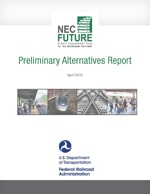The Obama Administration yesterday released its budget request for fiscal year 2014 and the President has once again put forth a plan for transforming and expanding train service in the United States.
The president is requesting $40 billion in passenger rail investment over the next five years, allocating $6.6 billion to the Federal Rail Administration for fiscal 2014, with increasing amounts each subsequent year through 2019.
“A well-functioning transportation system is critical to America’s economic future. Whether it is by road, transit, air, rail, pipeline, or waterway, Americans rely on our transportation system to move people and goods safely, facilitate commerce, attract and retain businesses, and support jobs,” the administration said in the budget request.
The request for $40 billion over five will fund the development of high-speed rail and other passenger rail programs as part of an integrated national transportation strategy.
This system will provide 80 percent of Americans with convenient access to a passenger rail system, featuring high-speed service, within 25 years.
The proposal also benefits freight rail and significantly restructures Federal support for Amtrak, to increase transparency, accountability, and performance.
The request will be a boost for Amtrak, coming a day before the House Committee on Transportation holds a hearing on the railroad’s FY 2014 budget.
The hearing, Amtrak’s Fiscal Year 2014 Budget: The Starting Point for Reauthorization [which will be streamed live], will address Amtrak’s funding needs, as well as the coming rail reauthorization (the current law will expire at the end of this September).
Amtrak announced April 9 it had set a new ridership record during the first half of this fiscal year, and will be looking to translate its steady increase in popularity into an increase its funding for badly needed equipment purchases and infrastructure upgrades.
Passage of a reauthorization bill this year is uncertain, but the appropriations committees will determine how much federal funding each program gets.
Secretary LaHood is scheduled to appear before the House Appropriations transportation subcommittee on April 16.
President Obama’s $6.6 billion request breaks down in the following ways:
• $2.7 billion for “Current Passenger Rail Service,” including $800 million for Amtrak’s long-distance routes, $300 million for state corridors, $675 million for the Northeast Corridor and $925 million for “national assets” (defined as positive train control for passenger rail, rail stations, and “backbone rail facilities).”
• $3.7 billion for “Rail Service Improvement Program.” The budget request defines goals for the program as “Creating or improving passenger corridors, mitigating congestion bottlenecks in the rail system, improving intermodal freight rail capacity and comprehensive future planning.”
President Obama has put forth similar proposals in the past, and the biggest obstacle to implementing the program remains identifying new sources of funding.
The Administration identifies the “peace dividend” — money saved from drawing down the wars in Afghanistan and Iraq — as a major source of funding. However, House Republicans have rejected this proposal in its previous iterations.
The Administration is proposing that rail funding become part of the Highway Trust Fund (it would be repurposed into a “Transportation Trust Fund”). This would eliminate Amtrak’s dependence on the annual appropriations cycle, moving it a grant structure similar to highways and transit.
 WASHINGTON — President Barack Obama last week re-nominated three individuals to serve on the National Mediation Board, which administers the Railway Labor Act affecting railroads and airlines.
WASHINGTON — President Barack Obama last week re-nominated three individuals to serve on the National Mediation Board, which administers the Railway Labor Act affecting railroads and airlines. The SMART Transportation Division’s CSX B&O General Committee (GO 049) has reached agreement with Bombardier Transit Services on a new contract for employees who will operate the Maryland to Washington commuter service known as MARC.
The SMART Transportation Division’s CSX B&O General Committee (GO 049) has reached agreement with Bombardier Transit Services on a new contract for employees who will operate the Maryland to Washington commuter service known as MARC.


 All railroaders and their friends and relatives are invited to participate in the 12th Annual FSC Rail Classic golf tournament at 1 p.m. Monday, May 6, at Sierra Lakes Golf Course in Fontana, Calif., according to Local 240 Chairperson Harry J. Garvin Jr.
All railroaders and their friends and relatives are invited to participate in the 12th Annual FSC Rail Classic golf tournament at 1 p.m. Monday, May 6, at Sierra Lakes Golf Course in Fontana, Calif., according to Local 240 Chairperson Harry J. Garvin Jr. The Federal Railroad Administration is currently managing a comprehensive planning effort to define, evaluate and prioritize future levels of investment in the Northeast Corridor (NEC) through 2040.
The Federal Railroad Administration is currently managing a comprehensive planning effort to define, evaluate and prioritize future levels of investment in the Northeast Corridor (NEC) through 2040.